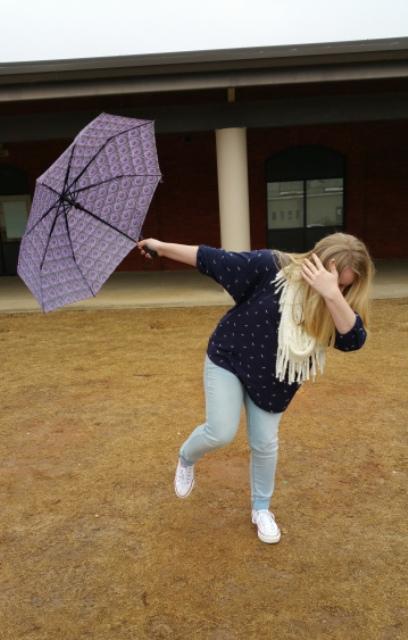Paranoia for the Survivalist: Natural Disasters
Even a rainstorm has the potential to be dangerous. It can cause roads to be dangerous by blinded drivers. Here is a step by step guide.
March 18, 2015
At least once in our lives, we have had a brief, panicky, moment when we leave our mind to think about “what if’s.” “What if my house were to catch on fire when I was asleep?” “What if I were to get caught in a blizzard?” “What if I was at the beach and a tsunami occurred?’
This piece is here to prepare for any natural disaster.
House Fire
A fire is a basic disaster. It almost always causes horrible damage, and, sometimes, it takes lives.
A person can be prepared for a fire 3 ways: with a smoke detector, a fire extinguisher, and a backup plan. To be safe, it is suggested that an owner of a house should install smoke alarms (in all locations, such as bedrooms). It is best to put them high up on a wall, so it can detect smoke faster, since there is more oxygen closer to the ground. It is also a good idea to have alarms connected to each other, so if one goes off, they all go off. Continuously replace the batteries every few months (when you change your clocks). When people think of ‘fire extinguisher, they automatically think of a red cylinder filled with white puffy stuff that extinguishes fires. (Check out how to use one of these extinguishers here.)While this is a good way to put out a fire, know that other objects (such as baking soda, urine, water, rugs/towels, sand, etc) can also be used as extinguishers. Lastly, make sure an escape plan is intact; have a meeting place for once everyone has gotten out of the house, such as the mailbox.
In a house a fire has already started, stay calm and try to escape quickly. Make sure, if possible, that everyone in the house is alerted, so they can also escape (This is where smoke alarms come in handy.) The air is more breathable and less toxic near the ground, so try to crawl out of the house. When coming to a door, feel the doorknob to see if it is warm/hot. If it is, then that means there is a fire on the other side, so be sure to try and exit another way. If there is no exit, depart through a window. On an upper level, throw bedding on the ground beneath the window to soften the fall. Always let an adult leave before a child, so they can catch the child (after lowering them as far as possible before letting go). When leaving, grab the ledge and suspend above the ground, and try to lowering down as much as possible before letting go. If there is trouble opening the window, break it with a heavy object (it might be wise to have a baseball bat under your bed). Another option is to use a sharp object; just make sure to cover it with something like a blanket or piece of clothing to protect the hand from getting hurt or cut. Also, put a towel under a door to clog the smoke; once that is done, call 911 immediately.
If someone’s clothes catch on fire, they need to immediately lie down on the ground and start rolling. If it still does not go out, put a heavy cloth, such as a coat or blanket, on top of the fire.
For information on how to survive a hotel fire, click here.
Wildfire
A lot of people like to camp or build their homes in forest settings. However, there is always a risk of a wildfire. Be prepared; wildfires can occur very easily. It is smart to plan an escape route with family and friends who stay or visit at the location. Also, look for safe zones. These zones can be a place with bodies of water or a location away from anything flammable. If you cannot find a safe zone, sometimes places already burned over by the fire will be safe. Just make sure to avoid getting near or lying down anything flammable, and avoid anything that could fall, such as a tree. Fire has a tendency to move uphill, so it is suggested to escape downhill. Make sure not go into or towards the fire to save material things. It can be determined how close the fire is by the closeness of the smoke.
(Here are some tips on what to do to try and prevent a wildfire.)
Earthquake
While it is nearly impossible to stop an earthquake, there are some things can be done during one to protect one’s self. If inside when an earthquake starts, drop down on hands and knees and crawl under a large object (like a table). Since the head and neck are vital, make sure they are covered, but, if possible, it is preferred to protect the whole body. Also, make sure to stay away from falling objects, or anything that could easily fall. Flying objects are the most dangerous, as well as damaging.
If outside, make sure to avoid buildings; do not try and go inside. Also, do not get near anything that could be considered dangerous (this includes even trees). Just drop down to the ground and wait for the shaking to pass.
In a car, pull over somewhere where there is no danger of falling objects (such as overhangs and power lines), and stop the car. Stay there until the shaking stops.
Click here for information on what to do in specific situations.
If you are interested to know details about the Mercalli intensity Scale, click the hyperlink.
(Click here for some ways to prevent damage.)
Tsunami
Tsunamis can be very dangerous. They are mostly caused by an earthquake or an ocean landslide. How it is handled can be a matter between life and death. Some possible signs of a tsunami are waves are moving at a strange level or an earthquake; however, sometimes, there are no signs of a tsunami.
In the ocean, make sure to get out of the water as quickly as possible. If a boat is not too far out sea, make sure to bring it to shore. If a boat is deep in the ocean, it should stay in place until otherwise noticed. If an earthquake is occurring, do not stay in place; move to higher ground.
If it is not possible to get on higher ground in time, stay in the house and go to the uppermost section. Stay away from the side closest to the ocean and do not go near any windows. It is advised to stay at the current location if the first tsunami wave does not hit you..
Listen to the radio and television for information regarding the tsunami and escape routes, especially before driving.
Here are pictures relating to tsunami survival.
Flood
There is not a 100% way to prevent a flood; however, it is possible to prevent some of the damage it can cause (flood insurance is advised). Make sure neighborhood drains and gutters are removed of debris. Just like a fire escape plan, have a flood escape plan and a place to go to be safe from the rising water. Also, make sure to have necessities on hand and in a vehicle such as medication, foodthat won’t spoil, water, flashlights, first aid, and etc. Also, make sure all vehicle’s gas tanks are filled. Have a list of valuables in a safe place, preferably high off the ground,so it is more likely to survive the flood.
If it is advised by a news channel or if water rises high enough, carry out your evacuation plan. (Note: Keep off roads that have started to flood.)
Find out what to do after a flood here.
(Here are some extra tips)
Volcano
Volcanic eruptions are very dangerous. There is an unlikely chance of survival anywhere near the eruption zone; however, if near a volcano, make sure to have an evacuation plan. It is highly suggested to listen to the media for information on what to do.
If a lava flow is coming, retreat immediately. If possible, use a vehicle. When driving, do not roll the car’s windows down. Also, watch the road for hazards. Avoid them whenever possible; if unavoidable, be careful not to get near any of them. However, if there is a lot of ash fall, do not drive and remain in the current location.
If inside, make sure family members and animals are inside. Seal all windows and doors, so volcanic ash cannot enter.
If outside, do not automatically run. Instead, look up at the sky to avoid getting hit by chunks of ruble or volcanic material, then immediately run for shelter.
Do not be anywhere near a body of water when an eruption appears close by. The water can easily transform into a dangerous mudslide. If a nearby body of water increases, escape to higher ground immediately.
It is wise to have a dust mask that protects from breathing in particles; it is also smart to wear goggles. If someone normally wears contacts, it is suggested to use glasses instead. Also, after the eruption, cover up any exposed skin as much as possible outdoors. If injured (such as a burn), consult a doctor. After a while, if side effects of the eruption do not pass, contact a doctor. For more information about ash fall, click here.
Click here for a step by step on volcanic eruption survival.
(If stuck in a mudslide as a result of the eruption, look at the Mudslide section.)
Mudslides/Landslides
Mud and landslides costs multiple lives every year.
In preperation for the chance of one of these occuring, it is advised to not have a home near any incline. This can include slopes or mountainous regions. If, however, a home is near an incline, always look for signs of a potential slide. This can be anything that hints at property leaning, like a tilted tree or a crack in the pavement. Lots of natural occurrences and disasters can indicate a potential slide such as an earthquake, volcanic eruption, or a rainstorm.
A mudslide/landslide can grow from harmless to deadly very quickly. Slides have been known to root even trees up from the ground with ease. It might be smart to have an evacuation plan and get to higher ground during a slide.
An important thing to remember is to watch and listen to news stations; reporters will give advice on what to do. One very important thing is to stay awake; it has been proven that most deaths from landslides occur when the victim is sleeping.
If you cannot escape in time, make sure you form you body into a ball and cover the head and neck to protect vitals.
Here is a list of potential warning signs.
Click here for a step by step on surviving landslides
Hurricane
Hurricanes can also be dangerous and cause a lot of damage. One thing to be sure to do is have an emergency kit; this should include necessities like clean water, nonperishable food, and medical supplies. Like in any bad storm, it is wise to not use technology (like your cell phone). When the storm starts, stay inside. It is suggested to go into a small room (such as a closet or bathroom) on the first floor or, preferably, a basement if available. It might be wise to turn off some appliances (because of its attraction to lightening). Also, do not bathe during the storm; the water can be life threatening if it is open to lightning.
Before going outside, make sure the storm has passed. Do not be fooled if it has come to a lull; it could just be the eye of the hurricane moving over the house. It is also highly suggested that to stay inside until someone with authority (like a news channel) says it is safe to go outside. Once outside, stay away from any down power lines or puddles.
(Here are some conditions, which you should evacuate under.)
Tornado
A common sign of an approaching tornado is a strangely colored sky (usually the color green). If this sign is seen, seek refuge immediately. It is important that to go to the lowest room in a house. Basements are most preferable, but if there is not one, go to a small room with no windows (like a bathroom or closet) on the first floor. However, be careful that a huge object is not directly above the room, just in case it falls through the ceiling.
Note: Like with many other natural disasters, make sure to have an emergency kit prepared.
In a car that cannot outdrive the tornado, pull over and stop the car on the side of the road.
If outside, drop to the ground (away from any big objects that could be taken from a tornado, like a tree or power line) and cover your body’s vitals (head and neck).
Here is a list of what to do during specific situations.
Blizzard
A blizzard can easily be dangerous, especially if caught outdoors.
One important thing to remember is to not go on the roads; don’t drive a car. It is suggested that if there is a storm warning for sometime soon, go to the store and stock up on necessities (non perishable food, water, etc). If it is unavoidable to drive during the snow storm, have an emergency kit in the vehicle filled with important supplies such as warm clothing, blankets, a heating pack, food and water, and etc. Make sure the car’s gas tank is filled and have a cell phone in case of emergency. Drive slowly and watch for ice on the road. If stuck on the road, call for help. It is suggested to roll a window down a tiny bit so the car doesn’t accidentally fill with dangerous fumes. (Snow in an exhaust pipe can be the cause of dangerous fumes).
In addition, be prepared for a power outage. Make sure to have flashlights with charged batteries, do not go outside, and keep warm.
Sand Storm/Dust Storm
These kinds of storms can easily become very dangerous, or leave someone with internal damage.
Even though the storm does not last very long, there are still many precautions to be taken.
When the storm is approaching, find shelter or a big object to take cover from. If no shelter is available, head in the oppoisite direction. Some of these storms are not particularly fast, so it is possible to drive away from them in time. If this option is not possible, pull over to a safe place and turn off all of the vehicle’s lights.
If a vehicle is not available, stay in the same location and wait for the storm to pass.
It is wise to have goggles, a mask, and petroleum jelly. Apply the petroleum jelly inside nostrils so it catches grains of sand that blow through the mask.














